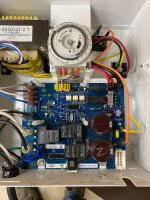Moved from here.
I have the dreaded Aqua-Trol with T-cell-5 and the r.1.47 (circa 2019) version on the controller.
I only have a 10k gal pool.
It is time for me to replace my cell and I found out that a Hayward replacement cell is $599
I would like to replace it with a generic cell (still hunting on this) but the replacement cells are mostly all 9 or 15
I have seen the posts discussing placing a jumper at the J4 on the PCB
Can someone with more understanding explain why the J4 jumper works?
If I place the jumper...and use a generic t-15 cell
Will this allow a t-15 cell to function at very low "desired output %" on my dial since the cell will be overkill for my small pool?
Will I still get accurate readings on my display (since the PCB was calibrated for a t-cell-5?
Will this modifications cause extra strain on system as some stated or have these issues been sorted out with newer PCB?
Thanks for your help
-Razzy8
I'm new to the forum and found this and other links related to my Hayward Aqua-trol controller.AFAIK, all Hayward swcg's are built with a 6 pin phone jack at the bottom. From the label it is a TROL-RJ-TL (Canadian). I can only assumed the original PCB was replaced with a TROL-HP model. To confirm the mainboard model, please run the diagnostic and post it here. Fyi, the Aquatrol uses a T-5 cell but you can use the larger T-15 cell by placing a jumper at J4 on the pcb.
Please take a gander at the below link for more info.
I have the dreaded Aqua-Trol with T-cell-5 and the r.1.47 (circa 2019) version on the controller.
I only have a 10k gal pool.
It is time for me to replace my cell and I found out that a Hayward replacement cell is $599
I would like to replace it with a generic cell (still hunting on this) but the replacement cells are mostly all 9 or 15
I have seen the posts discussing placing a jumper at the J4 on the PCB
Can someone with more understanding explain why the J4 jumper works?
If I place the jumper...and use a generic t-15 cell
Will this allow a t-15 cell to function at very low "desired output %" on my dial since the cell will be overkill for my small pool?
Will I still get accurate readings on my display (since the PCB was calibrated for a t-cell-5?
Will this modifications cause extra strain on system as some stated or have these issues been sorted out with newer PCB?
Thanks for your help
-Razzy8
Last edited by a moderator:


